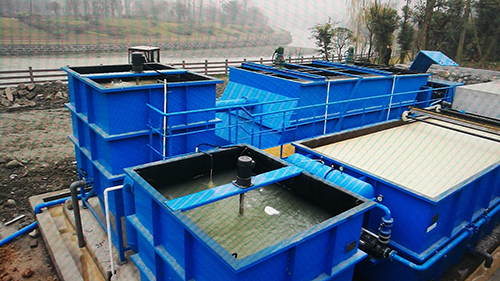Views: 888 Author: Yosun Publish Time: 2025-10-31 Origin: Site









The treatment of industrial and municipal wastewater is a critical step in protecting the environment and ensuring sustainable water use. The goal of every wastewater treatment process is to produce treated water that is safe for discharge or reuse. As industries face stricter discharge limits and higher water costs, efficient clarification systems are essential. One of the most effective technologies for achieving this is the Lamella Clarifier, a system based on inclined plate separation.
Treated water refers to wastewater that has undergone physical, chemical, or biological processes to remove contaminants. This water can be reused for non-potable purposes such as cooling, irrigation, or industrial washing. Producing high-quality treated water not only reduces fresh water demand but also supports regulatory compliance.
The level of treatment depends on the intended reuse. For example, secondary-treated water may be suitable for discharge into rivers, while tertiary-treated water may be reused in industrial systems. Clarification, as a major step in the treatment process, removes suspended solids and ensures that subsequent filtration or biological treatment operates effectively.
Lamella water treatment uses a compact design to separate suspended solids from wastewater through sedimentation. The Lamella Clarifier consists of a series of inclined plates that increase the effective settling area within a small footprint. As the water flows upward between the plates, suspended particles settle onto the surface and slide down into a sludge collection hopper. The clarified water then exits from the top of the unit.
Influent Distribution: Wastewater enters the clarifier evenly to prevent turbulence.
Inclined Plate Zone: Particles settle as they contact the lamella plates.
Sludge Collection: Sediment slides down to the hopper for discharge.
Effluent Discharge: Treated water exits from the top through an outlet channel.
This process allows lamella clarifiers to achieve the same separation efficiency as traditional clarifiers while occupying only a fraction of the space.
The efficiency of a lamella water treatment system depends on the surface area, plate angle, and flow rate. Each of these factors influences how effectively solids can settle out of the liquid.
| Parameter | Typical Value |
|---|---|
| Plate Inclination | 55°–60° |
| Surface Loading Rate | 1.5–3.0 m³/m²·h |
| Solids Removal Efficiency | 80–95% |
| Retention Time | 15–30 minutes |
The large effective settling area provided by inclined plates enhances clarification without increasing tank volume. The modular design also makes installation and maintenance convenient for both industrial and municipal wastewater treatment plants.

The lamella clarifier offers several advantages that make it a preferred choice in modern wastewater treatment facilities:
High efficiency: Maximized surface area improves settling performance.
Compact footprint: Requires less space than conventional clarifiers.
Stable operation: Handles variable flow rates with minimal performance loss.
Low maintenance: Few moving parts reduce operational downtime.
Consistent treated water quality: Produces clear effluent ready for secondary or tertiary treatment.
These characteristics allow the system to produce consistently high-quality treated water suitable for industrial reuse or compliant discharge.
Lamella water treatment technology is widely used across industries due to its reliability and compact design:
Municipal wastewater treatment plants: Used for primary or secondary clarification.
Food and beverage industry: Removes suspended solids and organic matter.
Petrochemical sector: Treats oily wastewater and improves effluent clarity.
Metal finishing plants: Separates fine metal hydroxides and polishing residues.
Power plants: Clarifies cooling tower blowdown and process water.
In all these applications, the lamella clarifier ensures that suspended solids are effectively removed before advanced filtration or disinfection stages.
Lamella clarifiers are often integrated with other systems to form a complete wastewater treatment solution.
Before biological treatment: Reduces suspended solids load to prevent biological system overload.
After coagulation and flocculation: Enhances the settling of aggregated particles.
Combined with DAF systems: Optimizes performance where both flotation and sedimentation are needed.
In tertiary treatment: Provides polishing clarification for reuse applications.
This versatility makes lamella water treatment a key technology in both new treatment plants and system upgrades.
The performance of a lamella clarifier depends on proper flow control and sludge management. Uniform flow distribution ensures even settling across all plate surfaces. Periodic sludge removal prevents re-suspension of settled solids, maintaining high effluent clarity.
| Operating Parameter | Recommendation |
|---|---|
| Inlet Flow Velocity | ≤ 1.0 m/h |
| Plate Spacing | 40–50 mm |
| Sludge Discharge Frequency | 1–2 times/day |
| Effluent Turbidity | < 10 NTU |
Routine maintenance includes cleaning of plate surfaces and checking the inlet baffles for blockages. When operated correctly, lamella clarifiers can run continuously with minimal supervision.
The use of lamella water treatment technology brings both environmental and economic benefits:
Reduced energy use: No need for mechanical mixing or large settling tanks.
Lower chemical consumption: Efficient clarification reduces coagulant demand.
Water conservation: High-quality treated water can be reused in multiple processes.
Small footprint: Ideal for retrofits or plants with space limitations.
By improving the efficiency of solid-liquid separation, lamella clarifiers contribute to cleaner discharge and sustainable water management.
